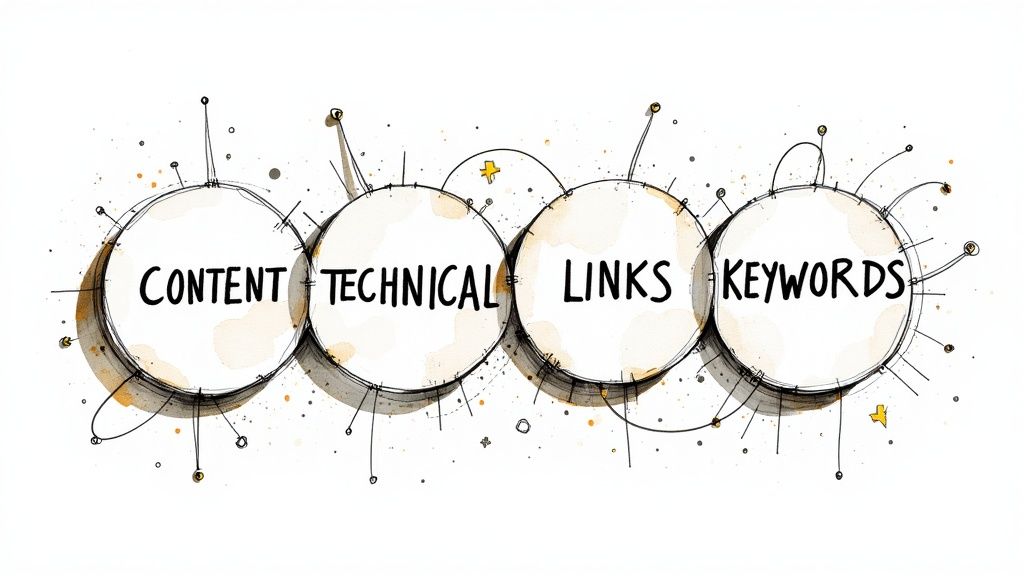Mastering Organic Search Engine Optimisation: A Comprehensive Guide

What is Organic SEO?

Organic search engine optimization (SEO) is all about improving your website's visibility in search engine results pages (SERPs) without paying for ads. This means that when a user searches for something related to your business, your website appears higher in the results naturally. It's like earning a medal for your skills, not buying it. This organic visibility is essential for attracting potential customers to your website and helping your business grow. For instance, if you sell handmade jewelry and someone searches for "unique silver earrings," organic SEO helps your website show up prominently in those search results.
This leads us to the question: why is organic SEO so important for businesses today?
Why is Organic SEO Important?
Organic SEO is essential for steady, long-term growth. While paid advertising can bring quick visibility, organic SEO builds a strong foundation for consistent traffic. This is because organic traffic is often highly targeted: people finding your website through organic search are actively searching for information or products related to what you offer. Furthermore, organic SEO builds trust and credibility. People often see organic results as more reliable and relevant than ads, resulting in higher click-through rates. This means investing in organic SEO is akin to nurturing a long-term relationship with your customers, building trust and loyalty over time. Now, let's explore how organic SEO actually works.
How Does Organic Search Engine Optimisation Work?
Organic SEO works by making sure your website aligns with what search engines (like Google) consider valuable and relevant to users. Search engines use complex algorithms to explore websites, analyze their content, and decide where they rank in search results. This analysis considers numerous factors, both on and off your website. For example, factors like the quality and relevance of your website content, the number and quality of links from other websites pointing to yours, and technical aspects like your website's loading speed and mobile-friendliness all contribute to your ranking. This means organic SEO is not a one-time task, but an ongoing process of optimizing and improving your website. It's much like tending a garden – consistent effort yields the best blossoms.
This attention to detail is what distinguishes websites that struggle on page ten from those that thrive at the top of page one. Understanding and implementing effective organic SEO strategies can dramatically improve your website's visibility, drawing in more of the right kind of visitors and enabling sustainable online growth. This brings us to the key components of organic SEO.
Key Components of Organic SEO

As we've seen, organic SEO is about earning your spot in search results, not buying it. But how exactly do you earn that coveted top ranking? It requires a careful combination of key components working together. Like a well-oiled machine, each part plays a vital role in the overall success of your organic SEO strategy. Let's break down these key components.
Keyword Research and Targeting
Imagine trying to find a specific book in a vast library without knowing its title or author. Keyword research provides the necessary guidance. It's the process of discovering the words and phrases people use when searching for information related to your business. Effective keyword targeting ensures your website content aligns with what your potential customers are actively searching for. For example, if you own an online bakery, keywords like "vegan chocolate cake delivery" or "gluten-free bread near me" would be valuable targets. This focused approach ensures your website appears in search results for users genuinely interested in your offerings.
Next, let's consider the importance of content itself.
High-Quality, Relevant Content
Think of a book: it needs compelling and informative content to keep the reader captivated. Similarly, creating high-quality content is vital for organic SEO. This means creating content that's not only relevant to your keywords but also truly valuable to your audience. This could include informative blog posts, engaging videos, in-depth product descriptions, or practical how-to guides. Your content is the substance that keeps users on your website, encouraging them to explore further, signaling to search engines that your site offers valuable resources. This relevance and value contribute directly to higher rankings in organic search results. Now, what about backlinks?
Backlinks: Votes of Confidence
Think of backlinks as recommendations from other library-goers pointing you towards a must-read book. In SEO, backlinks are links from other websites to yours. They act as endorsements, signaling to search engines that your website is a credible source of information. The more high-quality backlinks you have, the more authority your website gains. However, quality is more important than quantity. Earning backlinks from trusted and authoritative websites in your industry significantly strengthens your SEO. Search engines view these links as recommendations from respected sources, boosting your website's credibility.
Finally, let's explore the crucial role of technical SEO.
Technical SEO: The Foundation
Just as a library needs to be well-organized and easy to navigate, technical SEO is the foundation of your SEO efforts. It focuses on optimizing the technical aspects of your website to improve how easily search engines can crawl and index it. This includes optimizing your website's structure, improving page loading speed, ensuring mobile-friendliness, and implementing HTTPS for security. These technical elements may not be directly visible to users, but they are vital for how search engines perceive and rank your website. A technically sound website provides a seamless experience for both users and search engine crawlers, improving your ranking potential. By focusing on each of these components, you create a powerful SEO strategy that drives sustainable, long-term growth. This holistic approach sets the stage for online success. Let's move on to specific on-page SEO techniques to further refine your optimization efforts.
On-Page SEO Techniques
Now that we understand the key components of organic SEO, let's delve into on-page techniques – the specific actions you can take directly on your web pages to improve their visibility in search results. This is like fine-tuning the instruments of an orchestra to achieve a harmonious and powerful performance. Each element works together to create a website that both search engines and users love.
Optimizing Content for Relevance and Readability
One of the most important aspects of on-page SEO is creating high-quality, relevant content. This means crafting content that addresses your target audience's needs and interests while naturally incorporating relevant keywords. For instance, if you're optimizing a page about organic dog food, you might use keywords like "best organic dog food," "organic dog food brands," and "benefits of organic dog food." However, simply stuffing keywords into your content is ineffective. Instead, prioritize providing valuable information and a positive user experience. This includes using clear headings (like H2s and H3s), bullet points, and breaking up long blocks of text into smaller, digestible paragraphs. This makes it easier for both users and search engines to understand your content.
Next, let's discuss the importance of title tags and meta descriptions.
Using Title Tags and Meta Descriptions Strategically
Title tags and meta descriptions are essential elements of on-page SEO. The title tag is like the title of a book – it's the first thing users see in search results and heavily influences their clicking decisions. Your title tag should be concise, accurate, and include your primary keyword. The meta description is like a book's blurb; it provides a short summary of your page's content and encourages clicks. While meta descriptions don't directly affect rankings, they significantly influence click-through rates, which indirectly improves SEO. A compelling meta description makes users more likely to click your link, signaling relevance and value to search engines.
Now, let's talk about optimizing images and other media.
Optimizing Images and Other Media
Images and other media enhance user engagement and contribute to SEO. However, they also need optimization. This includes using descriptive alt text for images, which helps visually impaired users and provides context for search engines. Compressing images and optimizing video file sizes can improve page load speed, a crucial factor in both user experience and SEO. Faster-loading pages tend to rank higher and offer a more enjoyable user experience. This is like streamlining a race car; every unnecessary element is removed to maximize speed and efficiency, leading to better performance. By carefully addressing these on-page elements, you build a strong foundation for effective SEO. This thorough approach ensures your website appeals to both search engines and users, increasing visibility and driving targeted traffic. Now, let's turn our attention to the technical aspects of SEO.
Technical SEO Fundamentals

We've covered the importance of on-page optimization, but even a perfectly optimized page won't reach its full potential if the underlying technical structure is flawed. This is where technical SEO comes in. It's like the foundation of a house: even with beautiful interiors and a stunning facade, a weak foundation compromises the entire structure. Similarly, technical SEO is the base upon which all other SEO efforts are built. Let's explore the key aspects of technical SEO.
Site Structure and Navigation
A well-structured website is crucial for both users and search engines. For users, it means easy navigation and a pleasant browsing experience. For search engines, a clear structure helps them understand the relationship between pages and determine the relevance of your content. A logical site architecture, with a clear hierarchy of categories and subcategories, is vital. It's like a well-organized library – books are categorized systematically, making it easy to find what you’re looking for. A well-structured website allows search engines to easily "find" and categorize your content, a key factor in achieving high rankings. Now, let's turn to page speed.
Page Speed Optimization
Page speed is a critical SEO factor. Users expect fast loading times, and a slow site leads to high bounce rates and a negative user experience. Search engines also consider page speed when ranking websites. Optimizing your website's loading time is essential. Compressing images, minimizing JavaScript and CSS files, and using browser caching significantly improves page speed. These improvements, while often unseen by the user, significantly impact your website's performance and ranking. A fast-loading website, like a well-tuned engine, runs smoothly and efficiently, leading to a better overall experience. Next, let's address mobile optimization.
Mobile Optimization
With most internet users accessing the web through mobile devices, mobile optimization is essential for SEO. This means ensuring your website is responsive, adapting to different screen sizes and offering a positive experience on all devices. Google uses mobile-first indexing, meaning it primarily uses the mobile version of your website for ranking. This highlights the importance of mobile optimization. A mobile-friendly website ensures your content is easily accessible for mobile users, signaling to search engines that your site is optimized for the majority of users, boosting your mobile search ranking. Neglecting mobile optimization can severely hinder your SEO efforts in today’s mobile-centric world. Lastly, let's discuss website security.
HTTPS and Security
Website security is another vital aspect of technical SEO. Implementing HTTPS encrypts communication between your website and users' browsers, which is essential for user trust and search engine ranking. HTTPS protects sensitive user information and shows search engines that your website is secure and trustworthy, building user confidence and encouraging interaction. HTTPS is a ranking signal, meaning secure websites are preferred by search engines. Investing in security not only protects users but also improves search visibility. Search engines prioritize secure websites, recognizing their commitment to safety and data protection. Just like a solid foundation is crucial for a building, technical SEO supports a successful online presence, ultimately leading to higher rankings and increased organic traffic. Now, let's discuss content strategy for SEO.
Content Strategy for SEO
A strong content strategy is the backbone of effective SEO. It's the link between what your business offers and what your target audience seeks online. It's like creating a roadmap – knowing your destination (business goals) and how to get there (through engaging content). Careful planning and execution are essential for successful SEO. Let's explore how to create a winning content strategy.
Understanding Your Audience and Search Intent
Before creating content, understand your target audience and their search intent – their needs, motivations, and the information they seek. For instance, someone searching for "organic dog food" might want general information about its benefits, while someone searching for "best organic dog food for puppies" has a more specific need and is probably closer to buying. This understanding informs your content strategy and helps you craft truly relevant content. Now let's talk about keyword research and content mapping.
Keyword Research and Content Mapping
Keyword research is fundamental to SEO. It involves identifying the terms and phrases people use when searching for your products or services. After identifying relevant keywords, map them to specific website pages. This creates a clear content structure and helps search engines understand each page's focus. For example, if you sell handmade soaps, map "organic lavender soap" to that product page, while "benefits of using handmade soap" could link to a relevant blog post. This strategic mapping optimizes each page for relevant keywords, maximizing its ranking potential. Now, what about the content itself?
Creating High-Quality, Engaging Content
Simply targeting keywords isn't enough. Create informative and engaging content that provides value, answers questions, and addresses pain points. This could be blog posts, articles, videos, infographics, or even interactive tools. For example, if you’re targeting "organic gardening tips," create a blog post with practical advice, instructions, and images of thriving gardens. High-quality content keeps users engaged, encourages sharing, and signals to search engines that your site is a valuable resource. This brings us to content promotion.
Content Promotion and Distribution
Creating great content is only half the battle. You also need to promote it to reach a wider audience. Share it on social media, collaborate with influencers, participate in online communities, or even use paid advertising. This increases your content's reach, attracts more visitors, and enhances your chances of earning backlinks, which further boost your website's authority and ranking. For instance, sharing your organic gardening post in relevant online forums or Facebook groups can attract a targeted audience, leading to more shares, backlinks, and higher rankings. Combining high-quality content with strategic promotion maximizes your SEO success. Now let's discuss link-building strategies.
Link Building Strategies

We’ve discussed the importance of backlinks for SEO. Now let’s explore how to acquire these “votes of confidence” naturally. This means earning backlinks through genuine value and relevance, not through manipulative tactics that could damage your website's reputation. Think of it like building genuine relationships – true connections are based on mutual respect and benefit. This approach ensures sustainable, long-term SEO success. Let’s start with the foundation of link building: creating link-worthy content.
Creating Link-Worthy Content: The Cornerstone of Organic Search Engine Optimisation
The foundation of successful link building is high-quality, valuable content that other websites naturally want to link to. This could include original research, in-depth guides, insightful data visualizations, or engaging infographics. For example, a website about sustainable living could create a comprehensive guide on reducing your carbon footprint. This valuable content naturally attracts links from other related websites, strengthening your SEO. Valuable content becomes a resource for others, a natural target for backlinks, which boosts search engine rankings. Let's move on to guest blogging.
Guest Blogging: Sharing Expertise and Building Connections
Guest blogging is a great way to earn backlinks and increase visibility. Write high-quality articles for other reputable websites in your industry. By contributing valuable content, you reach a new audience and gain a backlink to your website. Focus on quality over quantity. Choose websites relevant to your niche with a strong audience. This targeted approach ensures your guest posts reach the right people and generate valuable backlinks. For instance, if you sell handmade jewelry, guest blogging on a fashion or lifestyle blog can expose your brand to a larger audience and earn a relevant backlink. Now let’s consider broken link building.
Broken Link Building: Turning Errors into Opportunities
Broken link building involves finding broken links on other websites and offering your content as a replacement. Identify relevant websites, find broken links, and contact the website owner to suggest your content as a suitable alternative. This helps them fix broken links while earning you a backlink. This approach strengthens your SEO and positions you as a helpful resource. Broken link building is highly effective when your content directly replaces the broken link's original purpose. Finally, let's talk about outreach.
Outreach and Relationship Building: The Human Touch in Organic Search Engine Optimisation
While great content is essential, proactive outreach is also vital for link building. Reach out to other website owners, bloggers, and influencers, sharing your valuable content. Building genuine relationships can lead to valuable backlinks and increased exposure. Avoid spammy or generic outreach. Personalize your messages and show genuine interest in their content. This personal touch makes a difference in building mutually beneficial relationships and earning quality backlinks. This genuine engagement fosters trust and lays the groundwork for long-term collaborations that boost your website’s authority. This approach, like networking, requires effort and authenticity, but the rewards are worth it. Now, let's discuss how to measure your SEO success.
Measuring SEO Success
You’ve implemented your SEO strategy – now how do you know if it’s working? Like tending a garden, you need to monitor its growth and adjust along the way. Measuring SEO success is crucial. By tracking the right metrics, you gain insights into what's working and what's not, allowing you to refine your efforts. These metrics are your compass, guiding you towards your SEO goals.
Key Metrics for Organic Search Engine Optimisation Success
Several key performance indicators (KPIs) gauge your SEO strategy's effectiveness, providing a complete picture of your website's organic search performance. This helps you identify areas for improvement and celebrate successes. These metrics are like a patient's vital signs, each telling a story about your SEO health.
- Organic Traffic: This measures visitors arriving through organic search. Increased organic traffic shows your SEO is attracting more users.
- Keyword Rankings: Your website's ranking for target keywords indicates your SEO success. Higher rankings mean greater visibility and more click-through opportunities. Ranking on Google's first page for your target keyword is a strong indicator of success.
- Click-Through Rate (CTR): CTR measures the percentage of users who click your search result link. A high CTR means your title tags and meta descriptions are enticing.
- Bounce Rate: Bounce rate is the percentage of users leaving after viewing only one page. A high bounce rate may indicate your content isn’t engaging or relevant. Improving content and user experience can lower your bounce rate.
- Conversion Rate: This measures the percentage of visitors completing a desired action (purchasing or contacting you). This is the ultimate SEO goal: driving valuable actions that benefit your business. Now, let's explore tools for tracking these metrics.
Tools for Tracking SEO Performance
Several tools can help you track these metrics and gain deeper SEO insights. They provide valuable data that empowers you to make informed decisions and optimize your strategy. They're your SEO toolkit, equipping you to analyze, track, and improve your results.
- Google Analytics: This free tool provides data on website traffic, user behavior, and conversions, revealing how users interact with your website.
- Google Search Console: Another free tool from Google, Search Console shows how Google views your website, offering data on keyword rankings, indexing issues, and technical errors.
- SEMrush: This paid tool provides features for keyword research, competitor analysis, and site auditing, helping you identify valuable keywords, track competitors, and uncover technical SEO problems.
- Ahrefs: Similar to SEMrush, Ahrefs is a paid tool for SEO analysis and competitive intelligence, offering insights into backlink profiles, keyword rankings, and content performance. By consistently monitoring these metrics and using these tools, you effectively track your SEO progress and make data-driven decisions to improve visibility and achieve your business goals. This continuous optimization is crucial for success in the dynamic world of organic search.
Ready to transform your Etsy store into a thriving independent e-commerce business? Wand Websites is your growth partner, providing expert design, strategy, and support to help you break free from marketplace limitations and achieve sustainable online success. Visit Wand Websites today to learn more and unlock your business's full potential.


